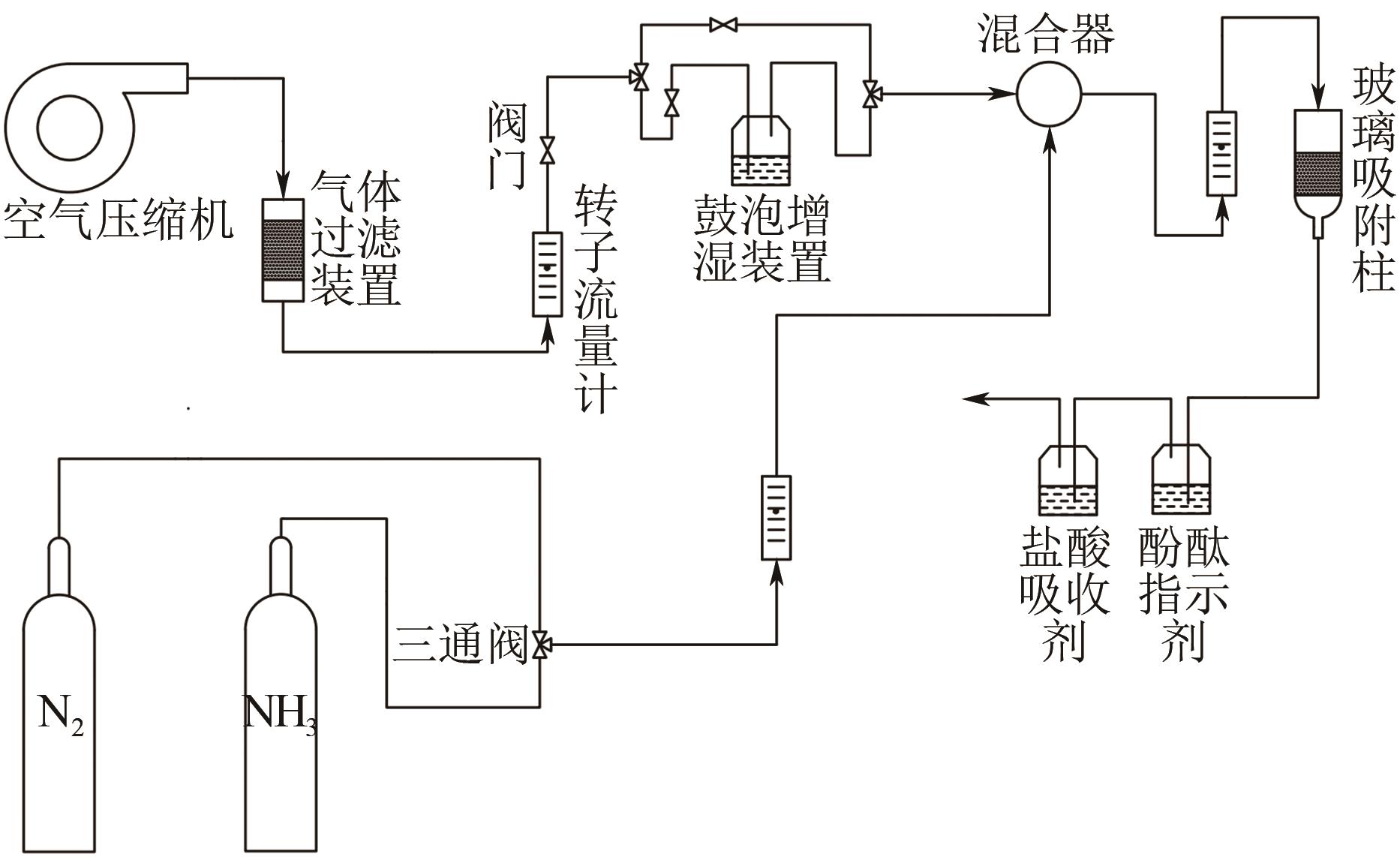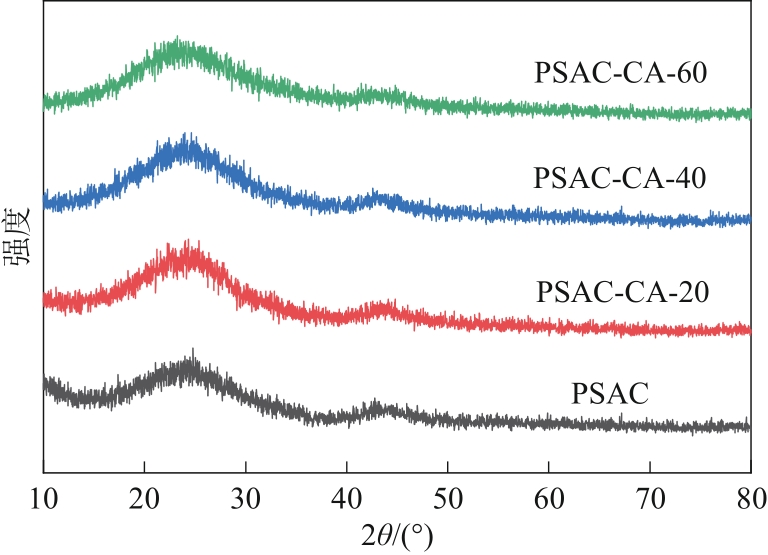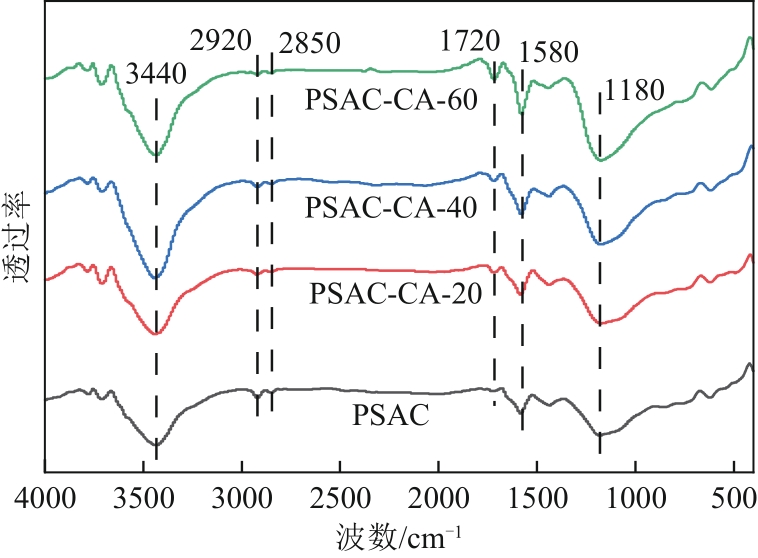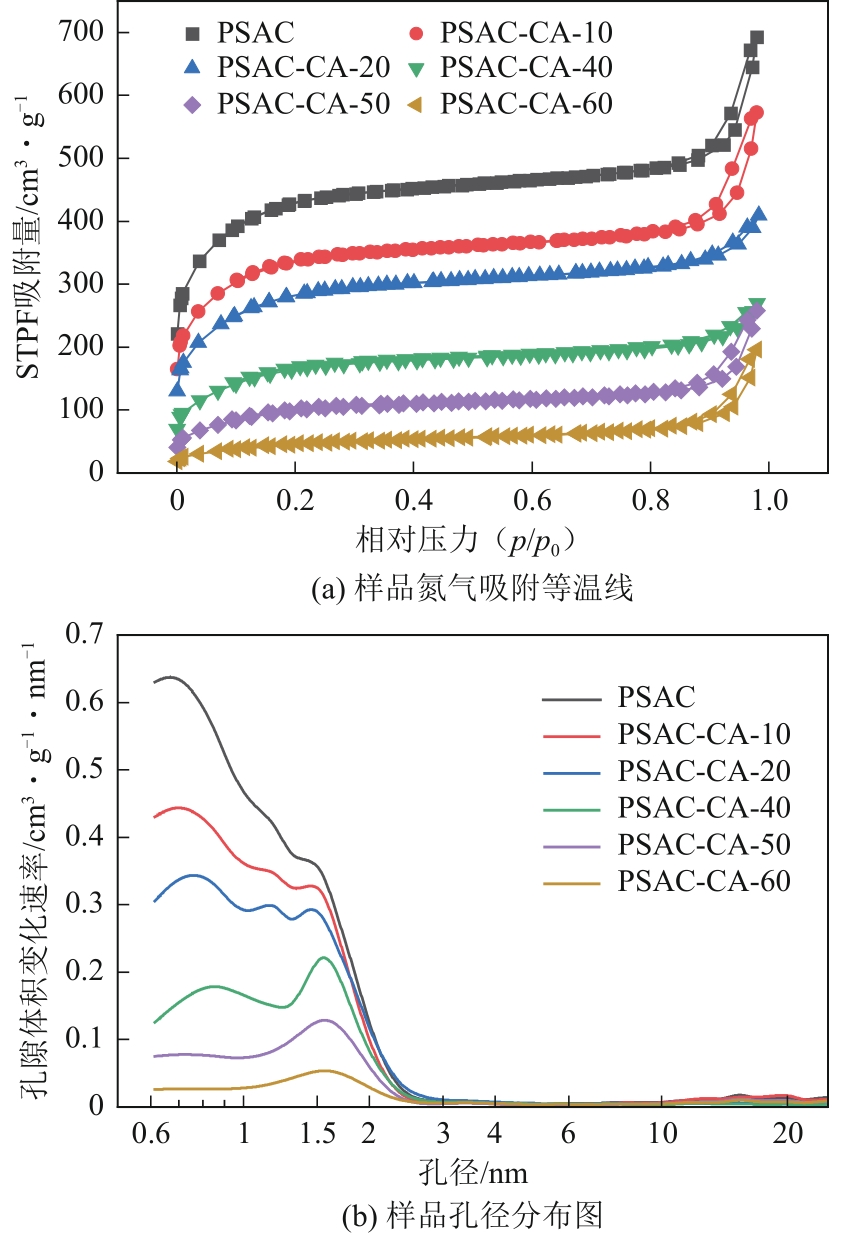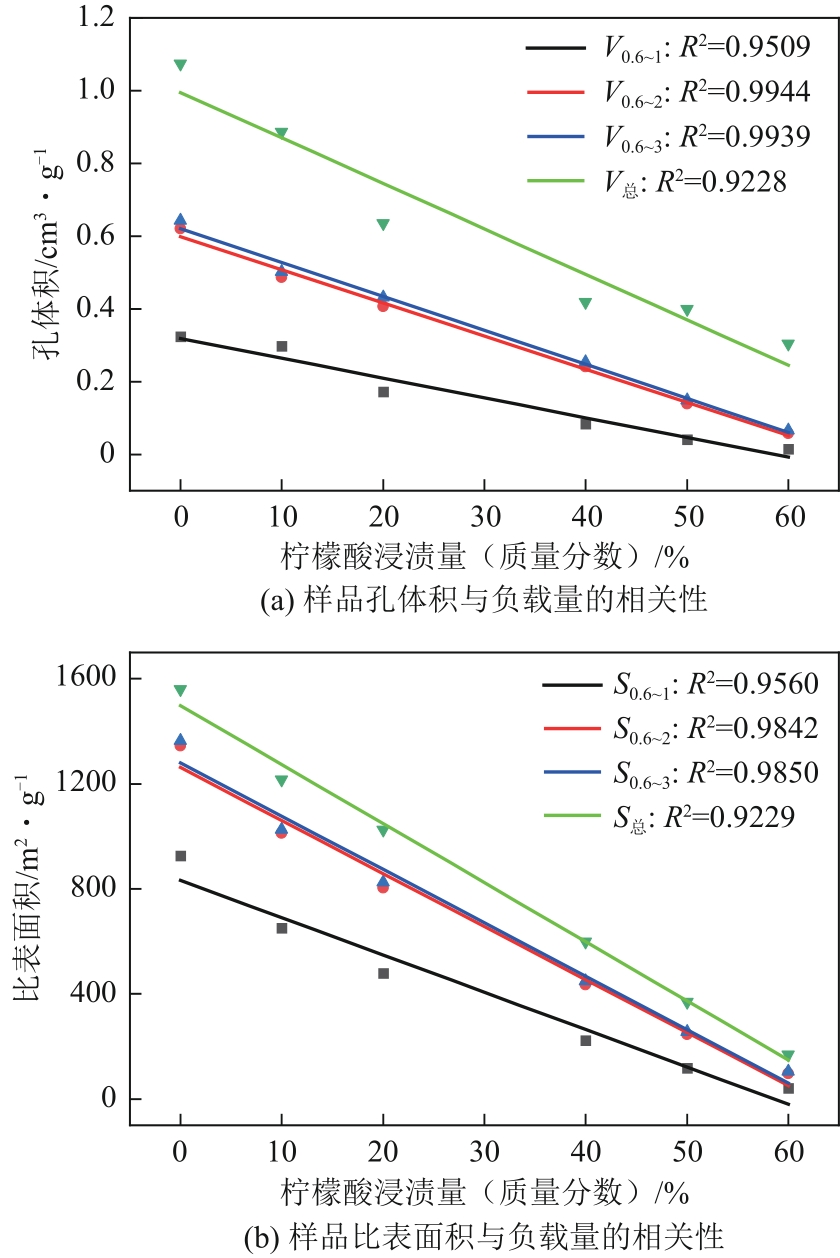Chemical Industry and Engineering Progress ›› 2024, Vol. 43 ›› Issue (2): 1082-1088.DOI: 10.16085/j.issn.1000-6613.2023-0290
• Resources and environmental engineering • Previous Articles
Effect of citric acid modification on the spherical activated carbon's ammonia adsorption performance
GUO Yingchun( ), LIANG Xiaoyi(
), LIANG Xiaoyi( )
)
- School of Chemical Engineering, East China University of Science and Technology, Shanghai 200237, China
-
Received:2023-02-28Revised:2023-05-08Online:2024-03-07Published:2024-02-25 -
Contact:LIANG Xiaoyi
柠檬酸改性球形活性炭对氨气吸附性能的影响
- 华东理工大学化工学院,上海 200237
-
通讯作者:梁晓怿 -
作者简介:郭迎春(1998—),女,硕士研究生,研究方向为活性炭脱氨。E-mail:gyc199818@163.com。
CLC Number:
Cite this article
GUO Yingchun, LIANG Xiaoyi. Effect of citric acid modification on the spherical activated carbon's ammonia adsorption performance[J]. Chemical Industry and Engineering Progress, 2024, 43(2): 1082-1088.
郭迎春, 梁晓怿. 柠檬酸改性球形活性炭对氨气吸附性能的影响[J]. 化工进展, 2024, 43(2): 1082-1088.
share this article
Add to citation manager EndNote|Ris|BibTeX
URL: https://hgjz.cip.com.cn/EN/10.16085/j.issn.1000-6613.2023-0290
| 样品名称 | 比表面积/m2·g-1 | 总孔体积/cm3·g-1 | 微孔体积/cm3·g-1 |
|---|---|---|---|
| PSAC | 1561 | 1.074 | 0.595 |
| PSAC-CA-10 | 1217 | 0.887 | 0.466 |
| PSAC-CA-20 | 1025 | 0.635 | 0.349 |
| PSAC-CA-40 | 599 | 0.419 | 0.217 |
| PSAC-CA-50 | 370 | 0.400 | 0.122 |
| PSAC-CA-60 | 169 | 0.304 | 0.042 |
| 样品名称 | 比表面积/m2·g-1 | 总孔体积/cm3·g-1 | 微孔体积/cm3·g-1 |
|---|---|---|---|
| PSAC | 1561 | 1.074 | 0.595 |
| PSAC-CA-10 | 1217 | 0.887 | 0.466 |
| PSAC-CA-20 | 1025 | 0.635 | 0.349 |
| PSAC-CA-40 | 599 | 0.419 | 0.217 |
| PSAC-CA-50 | 370 | 0.400 | 0.122 |
| PSAC-CA-60 | 169 | 0.304 | 0.042 |
| 样品名称 | 氨气防护时间 /min | 单位体积吸附剂的氨气 吸附容量/mg·mL-1 | pH |
|---|---|---|---|
| PSAC | 8 | 1.8 | 6.75 |
| PSAC-CA-10 | 40 | 8.8 | 4.64 |
| PSAC-CA-20 | 82 | 18.1 | 4.02 |
| PSAC-CA-40 | 135 | 29.8 | 3.30 |
| PSAC-CA-50 | 172 | 38.0 | 2.69 |
| PSAC-CA-60 | 194 | 42.8 | 2.65 |
| PSAC-CA-70 | 171 | 37.8 | 2.59 |
| 样品名称 | 氨气防护时间 /min | 单位体积吸附剂的氨气 吸附容量/mg·mL-1 | pH |
|---|---|---|---|
| PSAC | 8 | 1.8 | 6.75 |
| PSAC-CA-10 | 40 | 8.8 | 4.64 |
| PSAC-CA-20 | 82 | 18.1 | 4.02 |
| PSAC-CA-40 | 135 | 29.8 | 3.30 |
| PSAC-CA-50 | 172 | 38.0 | 2.69 |
| PSAC-CA-60 | 194 | 42.8 | 2.65 |
| PSAC-CA-70 | 171 | 37.8 | 2.59 |
| 样品名称 | 氨气浓度 /g·m-3 | 空气相对湿度/% | 单位质量吸附剂的 氨气吸附容量/mg·g-1 | 参考文献 |
|---|---|---|---|---|
| PSAC-CA-60 | 2.28 | 50 | 66.8 | 本文 |
| 12N N-AC | 7.6 | 80 | 41.6 | [ |
| 12N P-AC | 7.6 | 80 | 9.1 | [ |
| 12N S-AC | 7.6 | 80 | 11.2 | [ |
| 12N A-AC | 7.6 | 80 | 9.4 | [ |
| 12N C-AC | 7.6 | 80 | 3.8 | [ |
| MA2ox | 0.76 | 70 | 20.1 | [ |
| 样品名称 | 氨气浓度 /g·m-3 | 空气相对湿度/% | 单位质量吸附剂的 氨气吸附容量/mg·g-1 | 参考文献 |
|---|---|---|---|---|
| PSAC-CA-60 | 2.28 | 50 | 66.8 | 本文 |
| 12N N-AC | 7.6 | 80 | 41.6 | [ |
| 12N P-AC | 7.6 | 80 | 9.1 | [ |
| 12N S-AC | 7.6 | 80 | 11.2 | [ |
| 12N A-AC | 7.6 | 80 | 9.4 | [ |
| 12N C-AC | 7.6 | 80 | 3.8 | [ |
| MA2ox | 0.76 | 70 | 20.1 | [ |
| 1 | Huyen Thanh VO, KIM Jiyull, KIM Na Yeon, et al. Effect of pore texture property of mesoporous alumina on adsorption performance of ammonia gas[J]. Journal of Industrial and Engineering Chemistry, 2020, 91: 129-138. |
| 2 | HU Tingting, LIU Fang, DOU Shuai, et al. Selective adsorption of trace gaseous ammonia from air by a sulfonic acid-modified silica xerogel: Preparation, characterization and performance[J]. Chemical Engineering Journal, 2022, 443: 136357. |
| 3 | MAITLO Hubdar ALI, MAITLO Ghulamullah, SONG Xiangru, et al. A figure of merits-based performance comparison of various advanced functional nanomaterials for adsorptive removal of gaseous ammonia[J]. Science of the Total Environment, 2022, 822: 153428. |
| 4 | BEHERA Sailesh N, SHARMA Mukesh, ANEJA Viney P, et al. Ammonia in the atmosphere: A review on emission sources, atmospheric chemistry and deposition on terrestrial bodies[J]. Environmental Science and Pollution Research, 2013, 20(11): 8092-8131. |
| 5 | 陈沛坤, 张袁斌, 崔希利, 等. 氨气深度脱除材料与技术研究进展[J]. 化工进展, 2021, 40(7): 3957-3975. |
| CHEN Peikun, ZHANG Yuanbin, CUI Xili, et al. Progress in materials and technologies for deep removal of ammonia gas[J]. Chemical Industry and Engineering Progress, 2021, 40(7): 3957-3975. | |
| 6 | WANG Xiaohong, CHENG Hairong, YE Guangzheng, et al. Key factors and primary modification methods of activated carbon and their application in adsorption of carbon-based gases: A review[J]. Chemosphere, 2022, 287: 131995. |
| 7 | 金春江, 王鲁元, 陈惠敏, 等. 一步快速活化法制备生物质活性炭及其对乙酸乙酯的吸附再生[J]. 化工进展, 2021, 40(S1): 446-455. |
| JIN Chunjiang, WANG Luyuan, CHEN Huimin, et al. Preparation of biomass activated carbon by one step rapid activation and its adsorption regeneration for ethyl acetate[J]. Chemical Industry and Engineering Progress, 2021, 40(S1): 446-455. | |
| 8 | 樊相汝, 羊依金, 郭旭晶, 等. 软锰矿-含油污泥基活性炭对亚甲基蓝的吸附特性[J]. 化工进展, 2022, 41(12): 6664-6671. |
| FAN Xiangru, YANG Yijin, GUO Xujing, et al. Study on the adsorption characteristics of methylene blue by soft manganese ore-oil sludge-based activated carbon[J]. Chemical Industry and Engineering Progress, 2022, 41(12): 6664-6671. | |
| 9 | BANDOSZ Teresa J, PETIT Camille. On the reactive adsorption of ammonia on activated carbons modified by impregnation with inorganic compounds[J]. Journal of Colloid and Interface Science, 2009, 338(2): 329-345. |
| 10 | WANG Jitong, JIANG Wuyou, ZHANG Zixiao, et al. Mesoporous carbon beads impregnated with transition metal chlorides for regenerative removal of ammonia in the atmosphere[J]. Industrial & Engineering Chemistry Research, 2017, 56(12): 3283-3290. |
| 11 | 郭军军, 金彦任, 崔洪, 等. 空气氧化对沥青基球形活性炭的改性研究[J]. 炭素技术, 2021, 40(5): 63-67. |
| GUO Junjun, JIN Yanren, CUI Hong, et al. Effect of air modification on pitch-based spherical activated carbon[J]. Carbon Techniques, 2021, 40(5): 63-67. | |
| 12 | 谢菲, 王艳莉, 詹亮, 等. 沥青基球形活性炭对CO2的吸脱附行为研究[J]. 无机材料学报, 2011, 26(2): 149-154. |
| XIE Fei, WANG Yanli, ZHAN Liang, et al. Adsorption/desorption performance of CO2 on pitch-based spherical activated carbons[J]. Journal of Inorganic Materials, 2011, 26(2): 149-154. | |
| 13 | RASHID Umma Salma, BEZBARUAH Achintya N. Citric acid modified granular activated carbon for enhanced defluoridation[J]. Chemosphere, 2020, 252: 126639. |
| 14 | CHEN J Paul, WU Shunnian, CHONG Kai-Hau. Surface modification of a granular activated carbon by citric acid for enhancement of copper adsorption[J]. Carbon, 2003, 41(10): 1979-1986. |
| 15 | 傅成诚, 梅凡民, 周亮, 等. 改性活性炭对氨气吸附性能的研究[J]. 纺织高校基础科学学报, 2009, 22(3): 386-389. |
| FU Chengcheng, MEI Fanmin, ZHOU Liang, et al. Adsorption properties of modified activated carbon onto amonia[J]. Basic Sciences Journal of Textile Universities, 2009, 22(3): 386-389. | |
| 16 | LI Qi, ZHU Youyu, ZHAO Pinyi, et al. Commercial activated carbon as a novel precursor of the amorphous carbon for high-performance sodium-ion batteries anode[J]. Carbon, 2018, 129: 85-94. |
| 17 | AKPOTU Samson O, MOODLEY Brenda. Synthesis and characterization of citric acid grafted MCM-41 and its adsorption of cationic dyes[J]. Journal of Environmental Chemical Engineering, 2016, 4(4): 4503-4513. |
| 18 | WANG Xiangyu, WANG Anqi, MA Jun. Visible-light-driven photocatalytic removal of antibiotics by newly designed C3N4@MnFe2O4-graphene nanocomposites[J]. Journal of Hazardous Materials, 2017, 336: 81-92. |
| 19 | CHEN Bo, ZHU Zhiliang, MA Jie, et al. Surfactant assisted Ce-Fe mixed oxide decorated multiwalled carbon nanotubes and their arsenic adsorption performance[J]. Journal of Materials Chemistry A, 2013, 1(37): 11355-11367. |
| 20 | MADY Amr Hussein, BAYNOSA Marjorie Lara, TUMA Dirk, et al. Facile microwave-assisted green synthesis of Ag-ZnFe2O4@rGO nanocomposites for efficient removal of organic dyes under UV- and visible-light irradiation[J]. Applied Catalysis B: Environmental, 2017, 203: 416-427. |
| 21 | BEHERA Arjun, MANSINGH Sriram, Kundan Kumar DAS, et al. Synergistic ZnFe2O4-carbon allotropes nanocomposite photocatalyst for norfloxacin degradation and Cr (Ⅵ) reduction[J]. Journal of Colloid and Interface Science, 2019, 544: 96-111. |
| 22 | THOMMES Matthias, KANEKO Katsumi, NEIMARK Alexander V, et al. Physisorption of gases, with special reference to the evaluation of surface area and pore size distribution (IUPAC Technical Report)[J]. Pure and Applied Chemistry, 2015, 87(9/10): 1051-1069. |
| 23 | SEREDYCH Mykola, Denisa HULICOVA-JURCAKOVA, LU Gaoqing, et al. Surface functional groups of carbons and the effects of their chemical character, density and accessibility to ions on electrochemical performance[J]. Carbon, 2008, 46(11): 1475-1488. |
| 24 | HUANG Chen-Chia, LI Hongsong, CHEN Chien-Hung. Effect of surface acidic oxides of activated carbon on adsorption of ammonia[J]. Journal of Hazardous Materials, 2008, 159(2/3): 523-527. |
| 25 | ZHANG Yufang, XIAO Jianfei, ZHANG Tian C, et al. Synthesis of CuSiO3-loaded P-doped porous biochar derived from phytic acid-activated lemon peel for enhanced adsorption of NH3 [J]. Separation and Purification Technology, 2022, 283: 120179. |
| 26 | Maraisa GONÇALVES, Laura SÁNCHEZ-GARCÍA, DE OLIVEIRA JARDIM Erika, et al. Ammonia removal using activated carbons: Effect of the surface chemistry in dry and moist conditions[J]. Environmental Science & Technology, 2011, 45(24): 10605-10610. |
| [1] | PENG Cheng, XU Yilin, SHI Yujing, ZHANG Wen, LI Yutao, WANG Haoran, ZHANG Wei, ZHAN Xiuping. Research progress on the biochar modification and its remediation of herbicide-contaminated water and soil [J]. Chemical Industry and Engineering Progress, 2024, 43(2): 1069-1081. |
| [2] | SU Mengjun, LIU Jian, XIN Jing, CHEN Yufei, ZHANG Haihong, HAN Longnian, ZHU Yuanbao, LI Hongbao. Progress in the application of gas-liquid mixing intensification in fixed-bed hydrogenation [J]. Chemical Industry and Engineering Progress, 2024, 43(1): 100-110. |
| [3] | ZENG Yue, WANG Yue, ZHANG Xuerui, SONG Xiwen, XIA Bowen, CHEN Ziqi. Research progress of green ammonia synthesis from renewable energy and economic analysis of hydrogen-ammonia storage and transportation [J]. Chemical Industry and Engineering Progress, 2024, 43(1): 376-389. |
| [4] | CHEN Le, CHONG Hailing, ZHANG Zhihui, HE Mingyang, CHEN Qun. Synthesis of Cu-BTC modified by CTAB and its adsorption and separation of xylene isomers [J]. Chemical Industry and Engineering Progress, 2024, 43(1): 455-464. |
| [5] | DAI Hongjing, MA Xuehu, WANG Sifang. Adsorption technology and materials for the treatment of low and intermediate level radioactive wastewater [J]. Chemical Industry and Engineering Progress, 2024, 43(1): 529-540. |
| [6] | ZHANG Mingyan, LIU Yan, ZHANG Xueting, LIU Yake, LI Congju, ZHANG Xiuling. Research progress of non-noble metal bifunctional catalysts in zinc-air batteries [J]. Chemical Industry and Engineering Progress, 2023, 42(S1): 276-286. |
| [7] | HU Xi, WANG Mingshan, LI Enzhi, HUANG Siming, CHEN Junchen, GUO Bingshu, YU Bo, MA Zhiyuan, LI Xing. Research progress on preparation and sodium storage properties of tungsten disulfide composites [J]. Chemical Industry and Engineering Progress, 2023, 42(S1): 344-355. |
| [8] | CUI Shoucheng, XU Hongbo, PENG Nan. Simulation analysis of two MOFs materials for O2/He adsorption separation [J]. Chemical Industry and Engineering Progress, 2023, 42(S1): 382-390. |
| [9] | XU Jiaheng, LI Yongsheng, LUO Chunhuan, SU Qingquan. Optimization of methanol steam reforming process [J]. Chemical Industry and Engineering Progress, 2023, 42(S1): 41-46. |
| [10] | CHEN Chongming, CHEN Qiu, GONG Yunqian, CHE Kai, YU Jinxing, SUN Nannan. Research progresses on zeolite-based CO2 adsorbents [J]. Chemical Industry and Engineering Progress, 2023, 42(S1): 411-419. |
| [11] | XU Chunshu, YAO Qingda, LIANG Yongxian, ZHOU Hualong. Research progress on functionalization strategies of covalent organic frame materials and its adsorption properties for Hg(Ⅱ) and Cr(Ⅵ) [J]. Chemical Industry and Engineering Progress, 2023, 42(S1): 461-478. |
| [12] | GU Yongzheng, ZHANG Yongsheng. Dynamic behavior and kinetic model of Hg0 adsorption by HBr-modified fly ash [J]. Chemical Industry and Engineering Progress, 2023, 42(S1): 498-509. |
| [13] | GUO Qiang, ZHAO Wenkai, XIAO Yonghou. Numerical simulation of enhancing fluid perturbation to improve separation of dimethyl sulfide/nitrogen via pressure swing adsorption [J]. Chemical Industry and Engineering Progress, 2023, 42(S1): 64-72. |
| [14] | WANG Shengyan, DENG Shuai, ZHAO Ruikai. Research progress on carbon dioxide capture technology based on electric swing adsorption [J]. Chemical Industry and Engineering Progress, 2023, 42(S1): 233-245. |
| [15] | LAI Shini, JIANG Lixia, LI Jun, HUANG Hongyu, KOBAYASHI Noriyuki. Research progress of ammonia blended fossil fuel [J]. Chemical Industry and Engineering Progress, 2023, 42(9): 4603-4615. |
| Viewed | ||||||
|
Full text |
|
|||||
|
Abstract |
|
|||||
